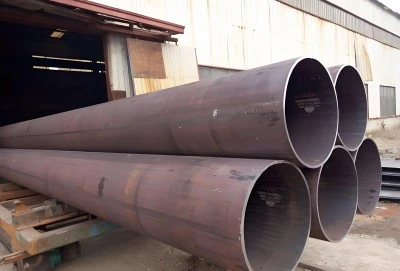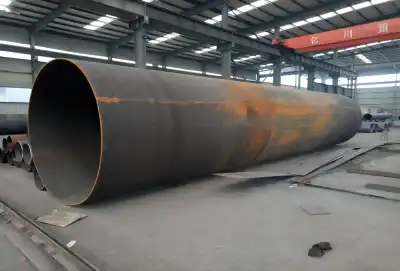In the world of pipe manufacturing and welding, two primary types of welds play crucial roles: longitudinal welds and transverse welds. Understanding the differences between these welding techniques is essential for engineers, contractors, and anyone involved in projects requiring high-quality long seam welded pipe solutions. This article will delve into the intricacies of longitudinal and transverse welds, exploring their applications, benefits, and impact on pipe integrity.
|
|
|
What is a Longitudinal Weld and How is it Applied in Pipes?
A longitudinal weld, also known as a long seam weld, runs parallel to the length of the pipe. This type of weld is commonly used in the production of long seam welded pipes, which are widely utilized in various industries, including oil and gas, construction, and water transportation.
The process of creating a longitudinal weld typically involves the following steps
- A flat steel plate or coil is rolled into a cylindrical shape.
- The edges of the plate are brought together to form a seam along the length of the pipe.
- The seam is then welded using various techniques, such as submerged arc welding (SAW) or electric resistance welding (ERW).
Long seam welded pipes produced using longitudinal welds offer several advantages:
- Consistent wall thickness throughout the pipe's length
- Ability to manufacture pipes with large diameters and thick walls
- High production efficiency for long pipe sections
- Excellent control over the welding process, resulting in high-quality welds
Longitudinal welds are particularly favored in the production of large-diameter pipes used in high-pressure applications, such as oil and gas pipelines. The long seam welded pipe manufacturing process allows for precise control over the weld quality, ensuring the pipe's ability to withstand high internal pressures and external forces.
What is a Transverse Weld and How Does it Differ from a Longitudinal Weld?
In contrast to longitudinal welds, transverse welds run perpendicular to the length of the pipe. These welds are typically used to join separate pipe sections together during installation or to create custom pipe fittings. The primary differences between transverse and longitudinal welds include:
- Orientation: Transverse welds are perpendicular to the pipe axis, while longitudinal welds run parallel to it.
- Application: Transverse welds are used to join pipe sections, whereas longitudinal welds are part of the pipe manufacturing process.
- Frequency: A single long seam welded pipe will have one longitudinal weld, but may have multiple transverse welds depending on the installation requirements.
- Stress distribution: Transverse welds experience different stress patterns compared to longitudinal welds due to their orientation relative to the pipe's axis.
The process of creating a transverse weld typically involves the following steps:
- Preparing the pipe ends to ensure proper fit-up
- Aligning the pipe sections to be joined
- Applying a root pass to establish initial connection
- Completing multiple weld passes to fill the joint
- Performing post-weld heat treatment if required
Transverse welds are critical in pipeline construction and maintenance, as they allow for the assembly of long pipelines from individual pipe sections. However, they require careful attention to detail during the welding process to ensure proper joint strength and integrity.
How Do Longitudinal and Transverse Welds Affect the Structural Integrity of Pipes?
Both longitudinal and transverse welds play crucial roles in determining the structural integrity of pipes. However, their effects on pipe performance can differ due to their orientation and the stresses they experience.
Longitudinal welds in long seam welded pipes:
- Are subject to hoop stress, which is the circumferential stress in the pipe wall resulting from internal pressure
- Must be carefully controlled during manufacturing to ensure uniform strength along the entire length of the pipe
- Can be optimized through advanced welding techniques to achieve mechanical properties similar to those of the base metal
- May require post-weld heat treatment to relieve residual stresses and improve overall pipe performance
Transverse welds in pipe joints:
- Experience axial stress, which is parallel to the pipe's longitudinal axis
- Are critical points in pipeline systems, as they can be potential weak spots if not properly executed
- Require careful attention to joint design, welding procedures, and non-destructive testing to ensure structural integrity
- May be subject to fatigue loading in applications with cyclic pressure or temperature changes
To ensure the structural integrity of pipes with both longitudinal and transverse welds, several factors must be considered:
- Material selection: Choosing appropriate pipe materials and welding consumables that are compatible and suitable for the intended service conditions.
- Welding procedures: Developing and qualifying welding procedures that produce high-quality welds with minimal defects.
- Quality control: Implementing rigorous inspection and testing protocols to verify weld quality and detect any potential flaws.
- Stress analysis: Conducting comprehensive stress analyses to ensure that both longitudinal and transverse welds can withstand the expected operating conditions.
- Corrosion protection: Applying appropriate coatings or cathodic protection systems to prevent corrosion-related failures at weld locations.
By carefully considering these factors, engineers and pipeline operators can maximize the structural integrity of piping systems that incorporate both long seam welded pipes and field-welded joints.
Contact LONGMA GROUP
Understanding the differences between longitudinal and transverse welds is crucial for ensuring the reliability and performance of piping systems across various industries. Long seam welded pipes, featuring longitudinal welds, offer excellent strength and versatility for large-diameter, high-pressure applications. Meanwhile, transverse welds play a vital role in joining pipe sections and creating custom fittings.
For those seeking high-quality long seam welded pipes that meet the most demanding industry standards, LONGMA GROUP is your trusted partner. With our state-of-the-art manufacturing processes and commitment to excellence, we deliver pipes that ensure the structural integrity and longevity of your projects.
Take the next step in enhancing your piping systems' performance and reliability. Contact LONGMA GROUP today at info@longma-group.com to discuss your specific requirements and discover how our long seam welded pipes can contribute to the success of your next project.














